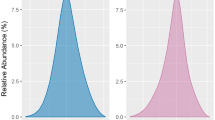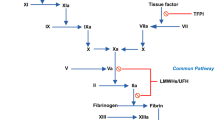Abstract
Low-molecular-weight heparins (LMWHs) have shown equivalent or superior efficacy and safety to unfractionated heparin as antithrombotic therapy for patients with acute coronary syndromes. Each approved LMWH is a pleotropic biological agent with a unique chemical, biochemical, biophysical and biological profile and displays different pharmacodynamic and pharmacokinetic profiles. As a result, LMWHs are neither equipotent in preclinical assays nor equivalent in terms of their clinical efficacy and safety. Previously, the US Food and Drug Administration (FDA) cautioned against using various LMWHs interchangeably, however recently, the FDA approved generic versions of LMWH that have not been tested in large clinical trials. This paper highlights the bio-chemical and pharmacological differences between the LMWH preparations that may result in different clinical outcomes, and also reviews the implications and challenges physicians face when generic versions of the original/innovator agents are approved for clinical use.






Similar content being viewed by others
Abbreviations
- ACS:
-
Acute coronary syndromes
- ANDA:
-
Abbreviated new drug approval
- EMA:
-
European Medicines Agency
- FDA:
-
United States Food and Drug Administration
- HIT:
-
Heparin-induced thrombocytopenia
- LMWH:
-
Low-molecular-weight heparin
- PCI:
-
Percutaneous coronary intervention
- PK/PD:
-
Pharmacokinetic/pharmacodynamic
- UA/NSTEMI:
-
Unstable angina/non-ST-elevation myocardial infarction
- UFH:
-
Unfractionated heparin
References
United States Food and Drug Administration (2010) Generic enoxaparin questions and answers. http://www.fda.gov/Drugs/DrugSafety/PostmarketDrugSafetyInformationforPatientsandProviders/ucm220037.htm. Accessed 9 Dec 2010
Woodcock J, Griffin J, Behrman R et al (2007) The FDA’s assessment of follow-on protein products: a historical perspective. Nat Rev Drug Discov 6:437–442
Frank RG (2007) Regulation of follow-on biologics. N Engl J Med 357:841–843
Federal Trade Commission (2009) Emerging health care issues: follow-on biologic drug competition. Federal Trade Commission, Washington
So AD, Katz SL (2010) Biologics boondoggle. Op-Ed. New York Times 8 March 2010
Dudzinski DM, Kesselheim AS (2008) Scientific and legal viability of follow-on protein drugs. N Engl J Med 358:843–849
Schellekens H (2009) Biosimilar therapeutics—what do we need to consider? Nephrol Dial Transplant Plus 2:i27–i36
Nightingale SL (1993) From the Food and Drug Administration. JAMA 270:1672
Fareed J, Jeske W, Hoppensteadt D, Clarizio R, Walenga JM (1996) Are the available low-molecular-weight heparin preparations the same? Semin Thromb Hemost 22:77–91
United States Food and Drug Administration (2010) Establishing active ingredient sameness for a generic enoxaparin sodium, a low molecular weight heparin. http://www.fda.gov/Drugs/DrugSafety/PostmarketDrugSafetyInformationforPatientsandProviders/ucm220023.htm. Accessed 9 Dec 2010
Bianchini P, Liverani L, Mascellani G, Parma B (1997) Heterogeneity of unfractionated heparin studied in connection with species, source, and production processes. Semin Thromb Hemost 23:3–10
United States Food and Drug Administration (2010) Information on adverse event reports and heparin. http://www.fda.gov/Drugs/DrugSafety/PostmarketDrugSafetyInformationforPatientsandProviders/UCM112669. Accessed 9 Dec 2010
United States Food and Drug Administration (2010) Countries with contaminated heparin API. http://www.fda.gov/bbs/topics/news/heparin/heparinmaps.html. Accessed 9 Dec 2010
Kishimoto TK, Viswanathan K, Ganguly T et al (2008) Contaminated heparin associated with adverse clinical events and activation of the contact system. N Engl J Med 358:2457–2467
Linhardt RJ, Gunay NS (1999) Production and chemical processing of low molecular weight heparin. Semin Thromb Hemost 25:5–16
Bianchini P, Mascellani G (2005) Few bicyclic acetals at reducing end of low-molecular-weight heparins: might they restrict specification of pharmacopoeia? Pharmeur Sci Notes 2005:1–3
Skidmore MA, Turnball JE (2005) Separation and sequencing of heparin and heparin sulphate saccharides. In: Garg H, Linhardt R, Hales C (eds) Chemistry and biology of heparin and heparin sulphate. Elsevier Press, NY
Jeske WP, Neville B, Ma Q, Hoppensteadt DA, Fareed J (2004) Effect of 1,6-anhdro bicyclic ring structure on the pharmacokinetic and pharmacodynamic behavior of low molecular weight heparin. Blood 104: A1868 (abstr)
Jeske W, Vandenberg C, Maddineni J, Florian M, Hoppensteadt D, Walenga JM (2006) Are generic LMWHs equivalent to the innovator products? FASEB J 20: A654 (abstr)
Jeske WP, Walenga JM, Hoppensteadt DA et al (2008) Differentiating low-molecular-weight heparins based on chemical, biological and pharmacologic properties: implications for the development of generic versions of low-molecular-weight heparins. Semin Thromb Hemost 34:74–85
Walenga J, Jeske W, Hoppensteadt D et al (2008) Differential heparin-induced thrombocytopenic potential of low molecular weight heparins. Int Angiol 27: 26 (abstr)
Gomes M, Ramacciotti E, Hoppensteadt D et al (2010) An open label, non randomized, prospective phase IV clinical trial evaluating the immunogenicity of branded enoxaparin versus biosimilar in healthy volunteers. ASH 1086 (abstr)
European Medicines Agency (2009) Guideline on non-clinical and clinical development of similar biological medicinal products containing low-molecular-weight-heparins. European Medicines Agency Committee for Medicinal Products for Human Use, London, pp 1–7
Cohen M, Demers C, Gurfinkel EP et al (1997) A comparison of low-molecular-weight heparin with unfractionated heparin for unstable coronary artery disease. Efficacy and safety of subcutaneous enoxaparin in non-Q-wave coronary events study group. N Engl J Med 337:447–452
Antman EM, Morrow DA, McCabe CH et al (2006) Enoxaparin versus unfractionated heparin with fibrinolysis for ST-elevation myocardial infarction. N Engl J Med 354:1477–1488
Montalescot G, White HD, Gallo R et al (2006) Enoxaparin versus unfractionated heparin in elective percutaneous coronary intervention. N Engl J Med 355:1006–1017
Nicolau JC, Cohen M, Montalescot G (2009) Differences among low-molecular-weight heparins: evidence in patients with acute coronary syndromes. J Cardiovasc Pharmacol 53:440–445
Michalis LK, Katsouras CS, Papamichael N et al (2003) Enoxaparin versus tinzaparin in non-ST-segment elevation acute coronary syndromes: the EVET trial. Am Heart J 146:304–310
Katsouras C, Michalis LK, Papamichael N et al (2005) Enoxaparin versus tinzaparin in non-ST-segment elevation acute coronary syndromes: results of the enoxaparin versus tinzaparin (EVET) trial at 6 months. Am Heart J 150:385–391
Montalescot G, Bal-dit-Sollier C, Chibedi D et al (2003) Comparison of effects on markers of blood cell activation of enoxaparin, dalteparin, and unfractionated heparin in patients with unstable angina pectoris or non-ST-segment elevation acute myocardial infarction (the ARMADA study). Am J Cardiol 91:925–930
Holmes DR Jr, Becker JA, Limacher MC, Granger CB, Page RL, Sila C (2011) ACCF/AHA 2011 health policy statement on therapeutic interchange and substitution: a report of the American College of Cardiology Foundation Clinical Quality Committee. Circulation 124:1290–1310
Chabner BA (2011) Drug shortages—a critical challenge for the generic-drug market. N Engl J Med 365:2147–2149
Gatesman ML, Smith TJ (2011) The shortages of essential chemotherapy drugs in the United States. N Engl J Med 365:1653–1655
Jensen V, Rappaport BA (2010) The reality of drug shortages—the case of the injectable agent propofol. N Engl J Med 363:806–807
Choudhry NK, Shrank WH (2010) Four-dollar generics—Increased accessibility, impaired quality assurance. N Engl J Med 363:1885–1887
French Cardiovascular Society (2010) Communiqué–Clopidogrel: des génériques retirés du marché! http://www.cardio-sfc.org/activites/informations/communiques-de-la-sfc/en-direct-de-la-sfc-2/communique-clopidogrel-des-generiques-retires-du-marche/. Accessed 9 Dec 2010
Nicolas A (2010) Les génériques sont-ils de bons médicaments? http://www.lefigaro.fr/sante/2010/06/20/01004-20100620ARTFIG00224-les-generiques-sont-ils-de-bons-medicaments.php. Accessed 9 Dec 2010
Villeléger JP (2010) Les médicaments génériques sont-ils fiables? http://www.lemonde.fr/idees/chronique/2010/10/17/les-medicaments-generiques-sont-ils-fiables_1427013_3232.html. Accessed 9 Dec 2010
European Medicines Agency (2010) European Medicines Agency recommends precautionary recall of batches of clopidogrel-containing medicines from Acino Pharma GmbH. EMA, London
Hamburg MA (2010) Innovation, regulation and the FDA. N Engl J Med 363:2228–2232
United States Food and Drug Administration. Warning Letters 1997–2010 [United States Food and Drug Administration Website]. http://www.fda.gov/Drugs/GuidanceComplianceRegulatoryInformation/EnforcementActivitiesbyFDA/WarningLettersandNoticeofViolationLetterstoPharmaceuticalCompanies/default.htm. Accessed 9 Dec 2010
Wood AJJ (2006) A proposal for radical changes in the drug-approval process. NEJM 355:618–623
Conflict of interest
Dr. Cohen has received/receives grant/research support from Sanofi, Johnson & Johnson, and Bristol-Myers Squibb. Served as a consultant to Datascope (now Maquet), Merck, and Sanofi-Aventis; member of the speaker bureau for Sanofi, Merck, and Bristol-Meyers Squibb, Boehringer Ingelheim, AstraZeneca, and Janssen. Dr. Jeske has received honoraria from Sanofi. Dr. Nicolau has research grant funding and/or honoraria from AstraZeneca, Bayer, Daiichi Sankyo, Eli Lilly & Co, Johnson & Johnson; GlaxoSmithKline; Merck, and Pfizer. Served as a consultant/advisory board member for AstraZeneca, Sanofi, and Merck. Dr. Montalescot has received grant and research support from Sanofi, Eli Lilly & Co, and Guerbet; received honoraria from Sanofi-Aventis, Eli Lilly & Co, GlaxoSmithKline, Merck, The Medicine’s Company, and Pfizer; and served on advisory boards for Sanofi-Aventis, Eli Lilly & Co, GlaxoSmithKline, Merck, The Medicine’s Company, and Schering Plough. Dr. Fareed has received honoraria from Sanofi.
Author information
Authors and Affiliations
Corresponding author
Rights and permissions
About this article
Cite this article
Cohen, M., Jeske, W.P., Nicolau, J.C. et al. US Food and Drug Administration approval of generic versions of complex biologics: implications for the practicing physician using low molecular weight heparins. J Thromb Thrombolysis 33, 230–238 (2012). https://doi.org/10.1007/s11239-012-0680-3
Published:
Issue Date:
DOI: https://doi.org/10.1007/s11239-012-0680-3




